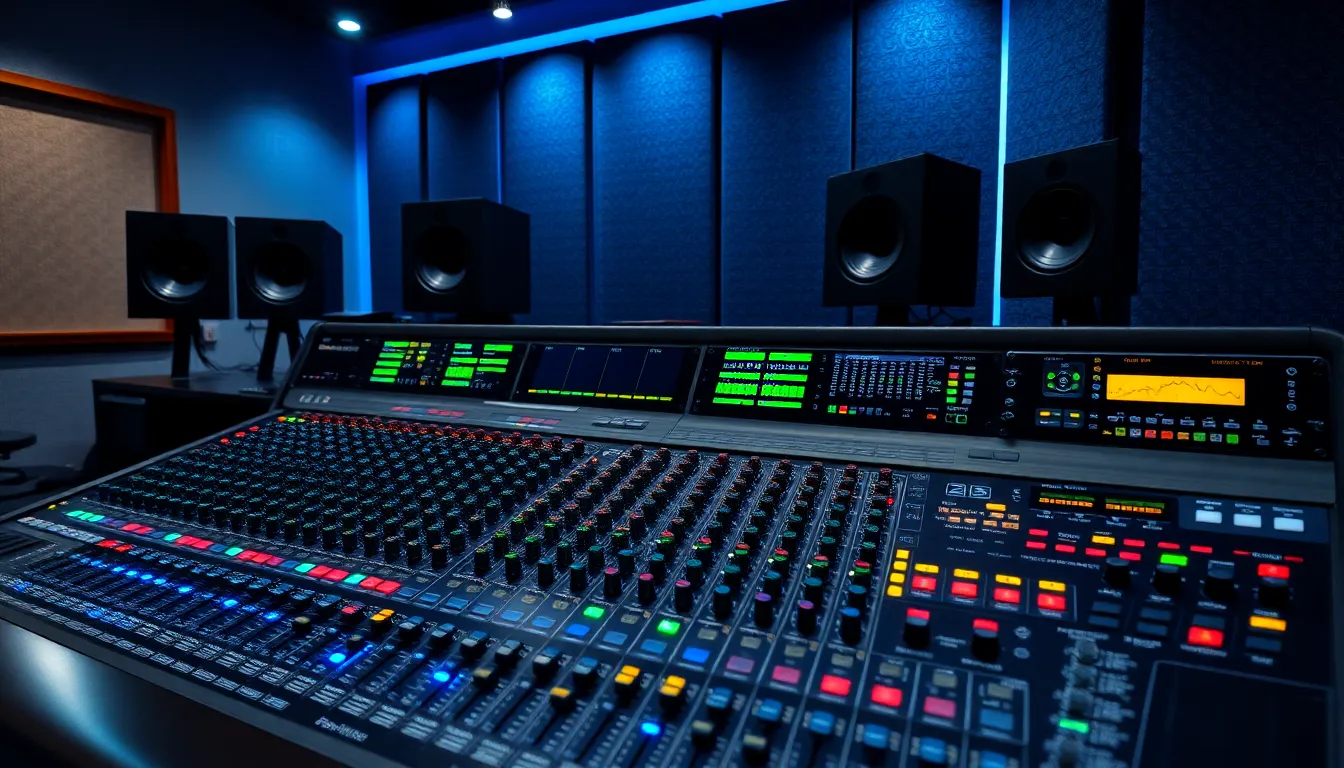Table of Contents
ToggleIn the vibrant world of audio production, audio mixing consoles are the unsung heroes, transforming chaos into harmony. Imagine a room filled with musicians, each pouring their heart into a track. Without the right console, it’s like trying to bake a cake without a mixer—good luck achieving that perfect blend!
Overview of Audio Mixing Consoles
Audio mixing consoles serve as the central hub in audio production. They facilitate the blending of various audio sources, such as vocals and instruments, into a harmonious final mix. Typically, these consoles consist of multiple channels, each equipped with controls for volume and tone adjustments.
Users can integrate various audio inputs, whether from microphones or instruments. Inputs connect seamlessly, allowing for easy management during recording sessions. Engineers rely on this organization to ensure clarity and balance, working intuitively to enhance sound quality.
Features on audio mixing consoles include equalizers, faders, and effects processors. Equalizers adjust frequencies, faders manage volume levels, and effects processors add depth and character. Together, these elements contribute to a tailored audio experience.
Different types of audio mixing consoles cater to specific needs. Analog consoles maintain a more traditional sound, while digital consoles offer advanced processing and flexibility. Each type appeals to particular genres and production styles, offering unique advantages.
Professionals often choose consoles based on several criteria, including budget, scalability, and user interface. A high-quality console can significantly impact the production quality. Understanding the available options helps engineers make informed decisions based on their particular requirements.
Ultimately, the use of audio mixing consoles is essential in presenting a fully realized audio product. Their sophisticated yet user-friendly design promotes creativity in the recording process. When utilized effectively, these consoles enhance both the quality and experience of audio production.
Key Features of Audio Mixing Consoles

Audio mixing consoles come equipped with several essential features that enhance audio production quality. Understanding these features helps users select the right console for their needs.
Channel Strips
Channel strips play a significant role in audio mixing consoles. Each strip typically includes inputs for audio sources, allowing the integration of vocals, instruments, or other sounds. Users find controls for adjusting gain, equalization, and panning located on these strips. This arrangement enables precise control over each audio signal. Additionally, channel strips often feature auxiliary sends to route audio to effects units or monitors, further expanding creative possibilities.
Faders and Controls
Faders and controls facilitate smooth adjustments in audio levels during mixing sessions. Each channel has its own fader, which allows for quick volume changes. Engineers rely on these faders to create dynamic mixes that capture the essence of a performance. Other controls, such as mute and solo buttons, offer intuitive ways to manage complex sessions. Users appreciate the tactile feedback from physical controls, which enhances their overall mixing experience.
Effects and Processing
Effects and processing options enrich the audio signal, adding depth and character to mixes. Most audio mixing consoles include built-in effects processors, such as reverb, delay, and compression. These effects can significantly transform sounds, allowing for creative experimentation. Users can apply processing directly within the console, streamlining the workflow. Importantly, high-quality effects contribute to a polished final product, making effective use of processing capabilities vital in professional audio production.
Types of Audio Mixing Consoles
Audio mixing consoles come in various types, each suited to different audio production needs. Understanding these types helps professionals choose the right console for their projects.
Analog vs. Digital Consoles
Analog consoles deliver a warm, classic sound that many professionals appreciate. These consoles utilize physical components, allowing for a tactile experience in audio mixing. Digital consoles, on the other hand, offer advanced processing capabilities and greater flexibility. They provide features like automation and extensive effects that can enhance the mixing process. Professionals often choose between them based on sound preference and project requirements.
Portable vs. Studio Consoles
Portable consoles offer convenience for on-the-go recording, usually featuring a lightweight design. These models are ideal for mobile setups, allowing for quick and easy transportation. Studio consoles, in contrast, emphasize durability and expansive channels. They provide a range of features suitable for extensive studio environments, accommodating larger mixing tasks. Professionals may choose based on session location and specific mixing needs.
Popular Brands and Models
Audio mixing consoles are prominent tools in the industry, with several reputable brands offering a range of models to suit various needs.
Brand A Models
Brand A is known for its high-quality analog and digital consoles. The XYZ 16 is a popular choice among professionals due to its 16 channels, which include built-in effects and intuitive controls. The ABC Digital Series offers advanced processing capabilities, making it ideal for live sound and studio recording scenarios. Users appreciate the seamless integration with digital audio workstations that this brand provides. Another excellent model is the DEF Compact, which combines portability with functionality, allowing for easy setup in smaller venues.
Brand B Models
Brand B has made a name for itself with its versatile digital consoles. The GHI Series features intuitive touch screens and a customizable layout. It supports up to 32 channels, catering to multitrack recording needs. Additionally, the JKL Analog Classic remains a favorite for those who prefer the warmth of analog sound. This model includes classic features such as classic EQs and built-in compressors. The MNO Mobile Mixer is compact yet powerful, making it suitable for traveling musicians and small events.
Audio mixing consoles are indispensable tools in the world of audio production. Their ability to blend various audio sources into a cohesive mix is crucial for achieving high-quality sound. Whether one opts for the warmth of an analog console or the versatility of a digital model, the choice ultimately hinges on individual needs and preferences.
With a wide range of features and brands available, professionals can find the right console that complements their workflow and enhances their creative output. Mastering the use of these consoles not only elevates the final product but also enriches the overall audio experience, making them a vital element in any recording or live sound environment.







